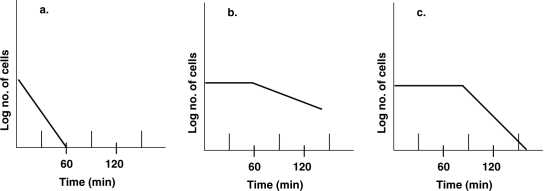A) The pattern varies depending on the species.
B) The pattern varies depending on the antimicrobial agent.
C) The cells in a population die at a constant rate.
D) All of the cells in a culture are never killed.
E) All the cells in a culture die at once.
Correct Answer

verified
Correct Answer
verified
Multiple Choice
Which of the following substances is the least effective antimicrobial agent?
A) Cationic detergents
B) Phenolics
C) Iodine
D) Soap
E) Alcohol
Correct Answer

verified
Correct Answer
verified
Multiple Choice
Table 7.3 The following data were obtained by incubating the bacteria in nutrient medium + disinfectant for 24 hr, then transferring one loopful to nutrient medium (subculturing.) -In Table 7.3, which disinfectant was bactericidal?
A) Doom
B) K.O.
C) Mortum
D) Sterl
E) Can't tell
Correct Answer

verified
Correct Answer
verified
Multiple Choice
Which of the following treatments is the most effective for controlling microbial growth?
A) 140°C for < 1 sec.
B) 63°C for 30 min.
C) 72°C for 15 sec.
D) They are equivalent treatments.
E) None are effective.
Correct Answer

verified
Correct Answer
verified
Multiple Choice
Which of the following pairs is not correctly matched?
A) Merthiolate - open wounds
B) Ag - burns
C) CuSO₄ - algicide
D) H₂O₂ - open wounds
E) None of the above
Correct Answer

verified
Correct Answer
verified
Multiple Choice
Which of the following could be used to sterilize plastic Petri plates in a plastic wrapper?
A) Ultraviolet radiation
B) Sunlight
C) Microwaves
D) Gamma radiation
E) None of the above
Correct Answer

verified
Correct Answer
verified
Multiple Choice
Figure 7.3
Assume 109 E. coli cells/ml are in a flask.
 -Which graph in Figure 7.3 best depicts the effect of placing the culture in an autoclave for 15 min. at time x?
-Which graph in Figure 7.3 best depicts the effect of placing the culture in an autoclave for 15 min. at time x?
A) a
B) b
C) c
D) d
E) e
Correct Answer

verified
Correct Answer
verified
Multiple Choice
Which of the following does not achieve sterilization?
A) Ethylene oxide
B) Autoclave
C) Dry heat
D) Formaldehyde
E) Pasteurization
Correct Answer

verified
Correct Answer
verified
Multiple Choice
Bacterial death will result from damage to which of the following structures?
A) Proteins
B) Cell wall
C) Nucleic acids
D) Plasma membrane
E) All of the above
Correct Answer

verified
Correct Answer
verified
Multiple Choice
Table 7.1 A disk- diffusion test using Staphylococcus gave the following results: -In Table 7.1, which compound was the most effective against E. coli?
A) A
B) B
C) C
D) D
E) Can't tell
Correct Answer

verified
Correct Answer
verified
Multiple Choice
Figure 7.1
 -In Figure 7.1, what is the thermal death time for culture a?
-In Figure 7.1, what is the thermal death time for culture a?
A) 150°C
B) 60 min.
C) 100°C
D) 120 min.
E) Can't tell
Correct Answer

verified
Correct Answer
verified
Multiple Choice
Glutaraldehyde is considered one of the most effective disinfectants for hospital use. Which of the following would not be true about glutaraldehyde?
A) Safe to transport.
B) Stains and corrodes.
C) Attacks all microorganisms.
D) Acts rapidly.
E) Not hampered by organic material.
Correct Answer

verified
Correct Answer
verified
Multiple Choice
Which of these is not an oxidizing agent?
A) Ozone
B) Iodine
C) Hydrogen peroxide
D) Chlorine
E) None of the above
Correct Answer

verified
Correct Answer
verified
Multiple Choice
Which of the following substances can sterilize?
A) Chlorine
B) Phenolics
C) Ethylene oxide
D) Alcohol
E) Soap
Correct Answer

verified
Correct Answer
verified
Multiple Choice
Which of the following is not a direct result of heat?
A) Denaturing enzymes
B) Breaking hydrogen bonds
C) Breaking sulfhydryl bonds
D) Cell lysis
E) None of the above
Correct Answer

verified
Correct Answer
verified
Multiple Choice
Foods are preserved with all of the following except
A) Potassium sorbate.
B) Sodium propionate.
C) Sodium nitrite.
D) Biguanides.
E) Nisin.
Correct Answer

verified
Correct Answer
verified
Multiple Choice
Which one of the following is most useful for disinfecting medical instruments?
A) Quats
B) Benzoic acid
C) Phenol
D) Bisphenols
E) Chlorine
Correct Answer

verified
Correct Answer
verified
Multiple Choice
Which of the following is best to sterilize heat- labile solutions?
A) Pasteurization
B) Dry heat
C) Autoclave
D) Membrane filtration
E) None of the above
Correct Answer

verified
Correct Answer
verified
Multiple Choice
Which of the following is not effective against nonenveloped viruses?
A) Ozone
B) Alcohol
C) Chlorine
D) Ethylene oxide
E) All are equally effective
Correct Answer

verified
Correct Answer
verified
Multiple Choice
Iodophors differ from iodine (I2) in that iodophors
A) Are combined with a nonionic detergent.
B) Are longer lasting.
C) Don't stain.
D) Are less irritating.
E) All of the above.
Correct Answer

verified
Correct Answer
verified
Showing 21 - 40 of 45
Related Exams